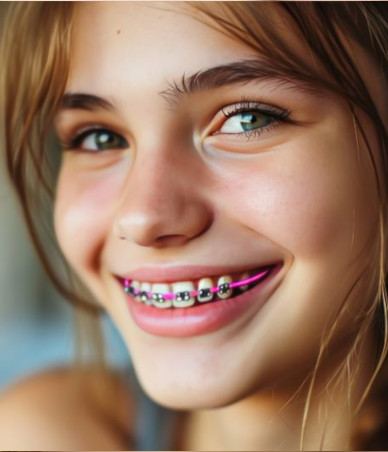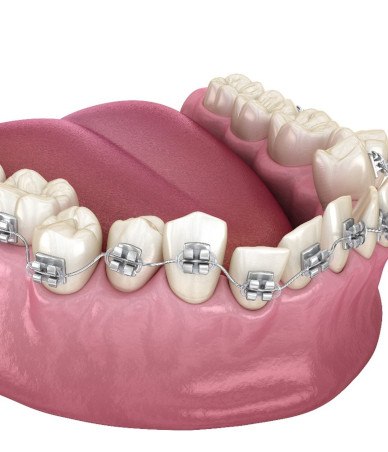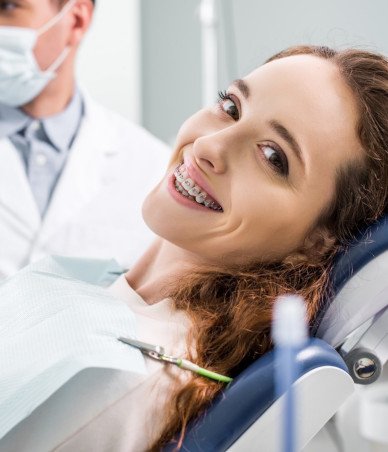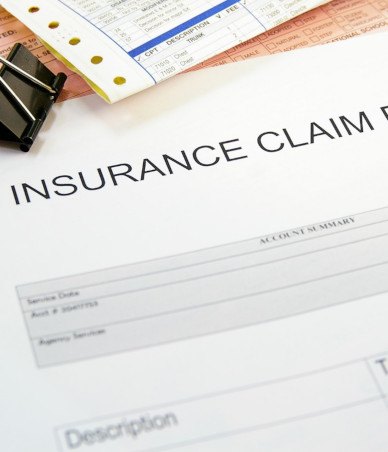Traditional Braces – Houston, TX
The Tried-and-True Way to Straighten Your Teeth

For decades, traditional metal braces have been patients’ go-to way to straighten their teeth due to the high success rate as well as durability. While Dr. Tom Hall is happy to continue recommending this tried-and-true treatment method, he also offers others, like InBrace and lingual braces, as a more discreet alternative. To learn whether you can benefit from traditional braces in Houston, call our orthodontic office today to schedule a consultation.
Why Choose Hall Orthodontics & TMJ for Traditional Braces?
- Passionate Orthodontist with 28+ Years of Experience
- Effective & Discreet Lingual Braces Treatment Available
- We Accept & Maximize Most Dental Insurance
How Do Traditional Braces Work?

Traditional braces apply a gentle, consistent amount of pressure to the teeth to gradually shift them into their ideal alignment. Using metal brackets and an archwire, they’re able to address crowding, gaps between teeth, bite misalignment, and rotated teeth, creating a straightened and optimally functional grin. Dr. Hall will apply brackets to each tooth that will hold a wire that can be adjusted throughout your treatment until your ideal results come to fruition.
Benefits of Traditional Braces

Traditional braces offer a wide range of benefits that makes them a top orthodontic treatment choice for patients across all age ranges, including:
- A solution that is easy to keep up with since they’re attached to your teeth at all times.
- One of the most affordable orthodontic treatments, as they’re covered by most dental insurance plans.
- The ability to choose from elastics ranging in a wide range of colors, making them great for teens.
- Reliable treatment results and a high success rate.
- Addresses a spectrum of orthodontic problems.
Tips for Living with Traditional Braces

Getting braces requires making adjustments to your day-to-day life. Here are some of our recommendations to maintain a healthy smile throughout your treatment:
- After your braces are tightened, stick to softer foods to help avoid irritation and increased discomfort.
- Be mindful of your chewing habits, being sure to avoid chewing on pens, fingernails, and other hard objects and foods.
- Brush your teeth after every meal, being mindful of cleaning all of the nooks and crannies of your mouth.
- Avoid sticky and hard foods and snacks.
- Floss your teeth throughout the day to avoid food and plaque build-up.
- Avoid using whitening products.
- Wear a mouthguard while playing sports.
- Bring an on-the-go dental kit with you so you can remain diligent about brushing and flossing, even when you’re not at home.
Understanding the Cost of Traditional Braces

The cost of traditional braces varies from case to case. Generally speaking, they are one of the more affordable orthodontic treatment options. During your consultation, our team can provide a personalized price estimate and help you understand your payment options. We want the financial aspect of your care to be as low-stress as possible!
Factors That Affect the Cost of Traditional Braces

Some factors that can influence the cost of traditional braces include:
- The severity of your dental misalignment. More complex, severe cases of misalignment may require more appointments with our team, more accessories, and a longer treatment timeline. Therefore, higher fees are to be expected.
- Your age. In most cases, adult orthodontic cases may be a bit more complex than those for younger people, so costs might be a bit higher. (We can also use accelerated orthodontics to speed up your results, which may affect the cost of your treatment but is a worthwhile investment!) Accelerated Orthodontics can treat most cases in less than 12 months safely and efficiently.
- Your compliance with treatment instructions. Hall may direct you to wear rubber bands or use other accessories to facilitate the movements of your teeth. Failure to comply with such guidelines might affect your treatment results and overall costs.
Professional Braces vs. “DIY” Braces: Which Costs More?

You might have seen some so-called “hacks” on social media that show people creating braces with household objects, such as fishing lines, paperclips, and super glue. While such ideas might seem like a tempting way to save money, they are not a reliable way to straighten teeth. They could harm your teeth and move them in the wrong direction! Correcting such issues with professional assistance can cost quite a bit of time and money. It is more economical and much safer to rely on professional treatment right from the beginning of your teeth-straightening journey.
Does Dental Insurance Cover Braces?

Some premium dental insurance plans cover up to 50% of the cost of orthodontic treatment, up to the amount of a plan’s lifetime orthodontic maximum. With the help of their insurance, some patients can reduce their out-of-pocket costs by up to $1,000 or more. Dr. Hall is in-network with many insurance plans, and our team will be happy to help you figure out how your benefits apply. We will also file all necessary claims on your behalf.
Options for Making Braces Affordable

If you do not have dental insurance, or your insurance will only cover a small portion of your treatment, you may be interested in breaking up the cost of your braces into affordable monthly installments. Most patients are eligible for low-interest financing through CareCredit. Our team can walk you through the application process.
Would you like to learn more about traditional braces and their cost? We would be pleased to assist you. Contact Hall Orthodontics &TMJ today to request a consultation.
Traditional Braces FAQs
Braces are a well-known solution for a crooked smile, but chances are there are one or two details about the treatment process that you aren’t completely sure of. We’re always happy for the chance to help our patients learn more about their care, so let us know if you have any questions about traditional braces and what you can expect from them. In the following FAQs, we have given our answers to a number of inquiries that many orthodontic patients have on their minds.
Am I Too Old to Get Braces? More Adults are Getting Braces!
Most people wear braces during childhood or their teenage years, but the treatment is still perfectly viable for adults. In order to qualify for traditional braces, your teeth and jawbone need to be sufficiently healthy. We can check your smile to confirm that braces are a good fit for you.
It’s important to note that adults can typically expect to wear braces longer than children. This is due to the fact that the teeth don’t move as easily once they have become firmly set in the jaw.
Luckily Dr Hall offers accelerated Orthodontic braces that allow more efficient tooth movements for all ages. The process involves a minor out patient office surgical procedure that also accelerates tooth movement by 2X-3X. This makes it possible to treat most adult orthodontic cases under 12 months.
Can I Get Traditional Braces on Just My Top or Bottom Teeth?
Technically, you can have traditional braces attached to just one row of teeth, but whether this is truly the best choice for your smile is another question altogether. Moving the teeth in only one arch could lead to issues with the alignment of your bite. This could make chewing more difficult, and it may even result in significant discomfort in your jaw.
Generally speaking, it’s better to get braces for both arches of teeth in order to ensure that the resulting bite is aligned as it should be. That said, there are certain situations where a single-arch treatment might be recommended.
Do Traditional Braces Hurt?
Braces are meant to help straighten your smile, and they do so by applying pressure to your teeth in order to move them toward new positions. Needless to say, this can result in some discomfort when you first begin your treatment. However, any soreness should only be temporary.
If you need help managing the discomfort associated with your braces, you can take ibuprofen or another kind of over-the-counter pain medication. Also, if any parts of your braces are irritating the inside of your mouth, you can cover the areas in question with a bit of orthodontic wax.
What Can You Not Eat with Traditional Braces?
When you’re wearing traditional braces, you need to be careful about what you eat. Refrain from consuming hard foods that might break your brackets and wires; nuts and unpopped popcorn kernels are particularly notorious examples. Other hard foods such as pizza crusts or raw vegetables can be safe to eat as long as you cut them into smaller pieces first. Additionally, it is recommended that you stay away from anything particularly sticky or chewy during the course of your orthodontic treatment.





